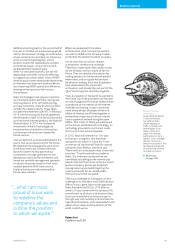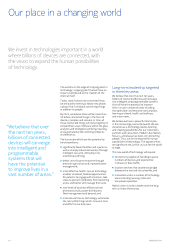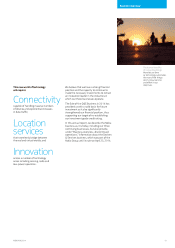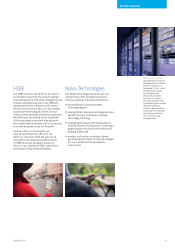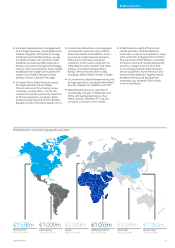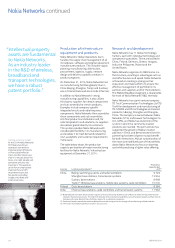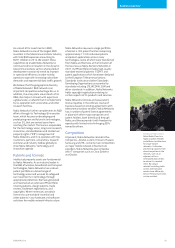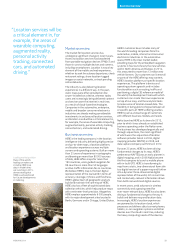Nokia 2014 Annual Report Download - page 21
Download and view the complete annual report
Please find page 21 of the 2014 Nokia annual report below. You can navigate through the pages in the report by either clicking on the pages listed below, or by using the keyword search tool below to find specific information within the annual report.
Business overview
19NOKIA IN 2014
Internet of Things
will impact networks
Nokia is demonstrating
two emerging mobile
technologies, 5G and
LTE-M, that will help to
make networks not only
faster but more reliable,
resilient and energy-ecient.
Market overview
Through its broad portfolio of products and
services, Nokia Networks addresses a market
described as “mobile infrastructure and
related services”. Demand for Nokia Networks’
portfolio is driven by the rapidly growing
requirement for greater bandwidth and
capacity in mobile networks globally.
Bandwidth requirements are rapidly
expanding as data-rich websites, applications
and video usage become more common.
In addition, the use of devices optimized
for rich content, including smartphones
and tablets, is on the increase.
Business overview
Nokia Networks’ portfolio ranges from the
hardware components of networks used
by mobile operators, such as base stations,
to software solutions that support mobile
networks, such as the core software that
underpins the operations of an operator.
Additionally, Nokia Networks provides the
services to plan, implement, run and upgrade
operators’ networks.
Nokia Networks is estimated to be the
third-largest company in its target market
of mobile infrastructure and related services.
Nokia Networks has a strong position in all
generations of radio network technologies
(2G, 3G and 4G) and the underlying core
networks software. In 3G, Nokia Networks
serves more operators than any of its rivals,
with more than one billion subscribers
connected through its 3G networks. In LTE,
Nokia Networks had 162 commercial contracts
at the end of 2014, and it is a key LTE radio
supplier to 15 of the world’s top 20 operators.
Nokia Networks is also estimated to be the
world’s third largest telecommunications
services vendor by revenue, managing 550
million subscribers in more than 100 operator
networks and close to one billion network
elements through its Global Delivery Centers.
Mobile consumers and businesses expect
an increase in technological capability with
little (if any) increase in price. As a result,
Nokia Networks’ overall market for mobile
broadband and related services is expected
to be attish in the next few years. Nokia
Networks is investing in new market
opportunities such as small cells, Telco Cloud,
data analytics, security and Internet of Things.
These will support Nokia Networks’ current
and new customers as they themselves
look for new sources of revenue from the
so-called quad-play (xed and mobile access,
internet and television) and seek eciency
improvements from the ongoing transition
to cloud computing.
More than 600 customers globally with a
total of almost ve billion subscriptions use
Nokia Networks’ equipment and services,
among them most of the world’s largest
mobile operators, including Bharti Airtel,
China Mobile, Deutsche Telekom, NTT
DoCoMo, SoftBank, Sprint, Telefónica,
Verizon and Vodafone.
Nokia Networks was formerly known as the
NSN business, which began operations as
Nokia Siemens Networks on April 1, 2007,
following a merger of the networks business
of Nokia and the carrier-related operations
of Siemens AG for xed and mobile networks.
Since August 7, 2013, the business has been
wholly owned by the Nokia Corporation and
is now operating under the Nokia brand.
Nokia Networks’ net sales totaled
EUR 11.2 billion, and total assets equaled
EUR 12.8 billion for 2014.
“Demand for Nokia
Networks’ portfolio is
driven by the rapidly
growing requirement
forgreater bandwidth
andcapacity in mobile
networks globally.”


